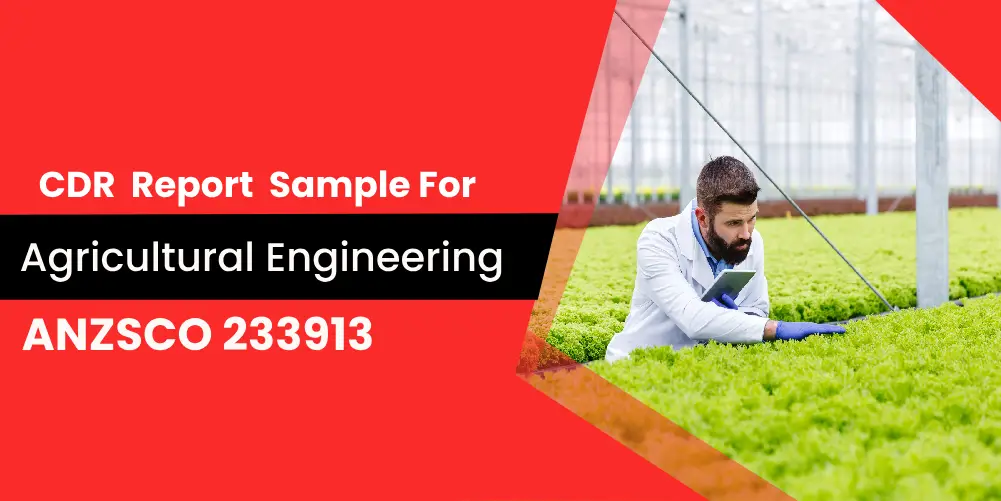Get Expert CDR, RPL, Stage 1, and Stage 2 Competency Samples for Reference
Contact to require a detailed analysis and assessment of your plan.
CDR Sample for Agricultural Engineering

For getting an employment in Agricultural Engineering Industry, a minimum qualification of a bachelor’s degree in engineering science is required, which is a pathway of four years. For agricultural engineers, there are jobs offered by farming industry, environmental and government agencies, as well as non-profit organizations. The chance of getting employed in Australia is higher for those who have enough knowledge and skills in agricultural machinery, soil science, fertilization, irrigation systems and crop nutrients along with some knowledge on mechanical and civil disciplines.
CDR sample for Agriculture Engineers includes all the required reports such Curriculum Vitae (CV), Continuing Professional Development (CPD), three Career Episodes (CE), Summary Statement.The content of the CDR Report Samples is given below:
Curriculum Vitae (CV):
Resume on the basis of a professional template.
Continuing Professional Development (CPD):
The sample of CPD clarifies the Engineering Knowledge of the applicant – 350 words.
Agricultural Engineer Career Episode Sample 1:
“ASSESSMENT OF DIFFERENT RICE MILLING MACHINES” – 2405 words
Agricultural Engineer Career Episode Sample 2:
“ADAPTATION OF DEHUSKING MACHINES” – 2070 words
Agricultural Engineer Career Episode Sample 3:
“PREPARING STRATEGIES OF FARM MECHANIZATION PROJECT” – 2160 words
Agricultural Engineer Summary Statement Sample:
Detailed explanation of all the competency element – 2065 words.
Agricultural Engineering Career Episode 1
Project Name: ASSESSMENT OF DIFFERENT RICE MILLING MACHINES
Project Type: Work Based Career Episode Project
Engineering Activities of Agricultural Engineer:
- To organise meetings and define the scope of the project for developing the methodology of the project
- To collect different rice samples for evaluation
- To design the experimental procedure using varied dials of milling machines
- To evaluate different rice mills according to the broken percentage of different types of rice
- To determine the milling capacity and efficiency of various milling machines
- To recommend the best milling practices to the farmers as well as authorise the buying procedure of various milling machines
- To prepare a report and train the subordinates on the testing/experimenting procedures of agricultural machines.
Problems & Solutions
Problem 1 Career episode 1 and its solution
Broken percentage of rice during the assessment
Problem 2 Career episode 1 and its solution
Safety issue in the milling process
Agricultural Engineering Career Episode 2
Project Name: ADAPTATION OF DEHUSKING MACHINES
Project Type: Work Based Career Episode Project
Engineering Activities of Agricultural Engineer:
- To obtain detailed information about buckwheat/buckwheat husk and design the dehusking machine using AutoCAD
- To design the grading and sieving unit of the dehusking machine
- To fabricate the separator using different mechanical tools and machines
- To prepare samples and carry out the dehusking procedure for testing the machine
- To check the performance of the machine for finding out the maximum dehusking speed
- To evaluate the dehusked buckwheat and make a report mentioning all the procedures adopted
- To implement the designed dehusking machine in the field.
Problems & Solutions
Problem 1 Career Episode 2 and its solution
Designed metal impeller damaging the buckwheat
Problem 2 Career Episode 2 and its solution
Exclusion of separator in the initial design
The author developed a separator and made two sections for husk and the dehusked buckwheat. The author kept a considerable distance between two sections of the separator to make sure dehusked buckwheat and husk do not mix. His coworkers fabricated the separator, and the machine was tested again. Finally, dehusked buckwheat and husk came out separately from two sections of the separator.
Agricultural Engineering Career Episode 3
Project Name: PREPARING STRATEGIES OF FARM MECHANIZATION PROJECT
Project Type: Work Based Career Episode Project
Engineering Activities of Agricultural Engineer:
- To research the current practices of agriculture with farm machinery/ need-based farm machinery by farmers and get familiar with them
- To suggest various solutions, strategy and requirements while preparing strategic planning.
- To coordinate in performing calculations related to work and power, speed, the rate of flow, fuel consumption, etc. in the design of farm machinery
- To approve and analyse the developed design in FEM based software
- To test the prototype design using various tools
- To monitor and evaluate research activities related to farm machinery going on across the country
- To supply the machinery and spare parts as ordered by the farmers and ensure the availability of backup services in time
- To provide training to key farmers, private manufacturers and stakeholders on various technologies used in farm machinery, their purposes, advantages and applications
- To inspect and control the quality of any farm machinery imported into the country
- To prepare and assess the standards of different farm machinery.
Problems & Solutions
Problem 1 Career episode 3 and its solution
Assessment of standards for Bhutanese farming context
Problem 2 Career episode 3 and its solution
Preparing as well as assessing relevant standards for diesel engine
Our Strengths
At WriteMyCDR, our core objective is to help clients secure successful skill assessment approvals by delivering well-structured, guideline-compliant reports tailored for migration purposes. We are committed to providing top-quality CDR services with a focus on accuracy, professionalism, and achieving 100% customer satisfaction.

Best Price Guarantee
We offer the most competitive rates without compromising on the quality of your report.

24/7 Service
If you have any questions or issues regarding your report, our experts are here to provide guidance and support.

Plagiarism Free Work
Get a fully original CDR report crafted by experienced professionals—plagiarism-free and tailored to meet official standards.

Best Price Guarantee
We offer the most competitive rates without compromising on the quality of your report.

24/7 Service
If you have any questions or issues regarding your report, our experts are here to provide guidance and support.

Plagiarism Free Work
Get a fully original CDR report crafted by experienced professionals—plagiarism-free and tailored to meet official standards.
